

Which Technology Tool Do I Choose? As my first post discussed, it is important when taking the leap of bringing digital tools into your classroom to think about your learning goals first.
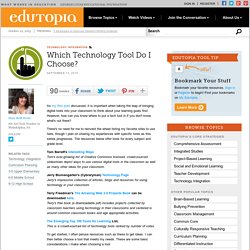
However, how can you know where to put a tech tool in if you don't know what's out there? There's no need for me to reinvent the wheel listing my favorite sites to use here, though I plan on sharing my experiences with specific tools as this series progresses. The resources below offer tools for every subject and grade level. Webtools4u2use.wikispaces. WebTools4U2Use will introduce you to a lot of different, powerful, useful tools.But... how do you choose the right one?
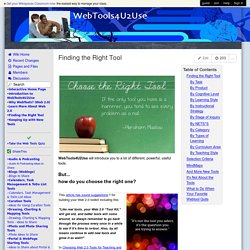
By Task This mindmap by Toy Waterman provides a basic list of webtools from which to choose those most appropriate to different kinds of classroom activities. Click on the + near each type of activity to see some of the best tools for that task. (Click and drag the image in the box to reveal more.) Bloom's Digital Taxonomy. Kathy Schrock's Guide to Everything - Home Page. Tech Tools by Subject and Skills. Every year, so many new technology tools for teachers are launched into the market that it can be nearly impossible to keep up with them all.
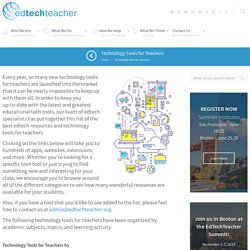
In order to keep you up-to-date with the latest and greatest educational tech tools, our team of edtech specialists has put together this list of the best edtech resources and technology tools for teachers. Clicking on the links below will take you to hundreds of apps, websites, extensions, and more. Whether you're looking for a specific tech tool or just trying to find something new and interesting for your class, we encourage you to browse around all of the different categories to see how many wonderful resources are available for your students. Also, if you have a tool that you'd like to see added to the list, please feel free to contact us at admin@edtechteacher.org. The following technology tools for teachers have been organized by academic subjects, topics, and learning activity. Backwards_edtech_tool_flow.pdf. Enquiring Minds. 100 Helpful Web Tools for Every Kind of Learner.
For those unfamiliar with the term, a learning style is a way in which an individual approaches learning.

Many people understand material much better when it is presented in one format, for example a lab experiment, than when it is presented in another, like an audio presentation. Determining how you best learn and using materials that cater to this style can be a great way to make school and the entire process of acquiring new information easier and much more intuitive. Here are some great tools that you can use to <a href=">cater to your individual learning style, no matter what that is. Visual Learners Visual learners learn through seeing and retain more information when it's presented in the form of pictures, diagrams, visual presentations, textbooks, handouts and videos. Auditory Learners Auditory learners do best in classes where listening is a main concern. Kinesthetic Learners Kinesthetic learners do best when they interact and touch things. Bloomin' Apps. This page gathers all of the Bloomin' Apps projects in one place.Each image has clickable hotspots and includes suggestions for iPad, Android, Google and online tools and applications to support each of the levels of Bloom's Revised Taxonomy.I have created a page to allow you to share your favorite online tool, iOS, or Android app with others.
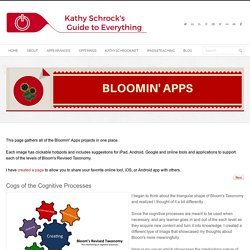
Cogs of the Cognitive Processes I began to think about the triangular shape of Bloom's Taxonomy and realized I thought of it a bit differently.Since the cognitive processes are meant to be used when necessary, and any learner goes in and out of the each level as they acquire new content and turn it into knowledge, I created a different type of image that showcased my thoughts about Bloom's more meaningfully.Here is my visual which showcases the interlocking nature of the cognitive processes or, simply, the "Cogs of the Cognitive Processes". Choosing Web 2.0 Tools for Teaching and Learning. By Tom Preskett Connecting formal education to social media/web 2.0 tools is a relatively new area.
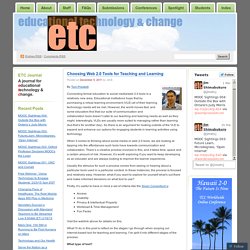
Educational institutions hope that by purchasing a virtual learning environment (VLE) all of their learning technology needs will be met. However, the world moves fast, and some educators find that our suite of communication and collaboration tools doesn’t cater to our teaching and learning needs as well as they might. Interestingly, VLEs are usually more suited to managing rather than learning (but that’s for another day). So there is an argument for looking outside of the VLE to expand and enhance our options for engaging students in learning activities using technology. When it comes to thinking about social media or web 2.0 tools, we are looking at tapping into the affordances such tools have towards communication and collaboration.
Usually the stimulus for such a process comes from seeing or hearing about a particular tools used in a particular context. 2011-01-07_1237.png (PNG Image, 570 × 359 pixels) Web 2.0 Tools Based on Bloom's Digital Taxonomy - Web 2.0 Tools Based on Bloom's Digital Taxonomy. 2010-18.pdf. DiRT Directory. RubiStar Home.